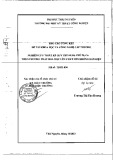
Many fructosamine 3-kinase homologues in bacteria are
ribulosamine⁄erythrulosamine 3-kinases potentially
involved in protein deglycation
Rita Gemayel, Juliette Fortpied, Rim Rzem, Didier Vertommen, Maria Veiga-da-Cunha and
Emile Van Schaftingen
Universite
´Catholique de Louvain, de Duve Institute, Brussels, Belgium
Fructosamine 3-kinase (FN3K) is a recently identified
enzyme that phosphorylates the Amadori products
fructosamines, leading to their destabilization and
removal from proteins [1–3]. FN3K is therefore respon-
sible for a new protein-repair mechanism. A related
mammalian enzyme (FN3K-related protein; FN3K-RP)
sharing 65% sequence identity with FN3K does not
phosphorylate fructosamines, but does phosphorylate
other ketoamines, mainly ribulosamines and erythrulos-
amines [4–6], as does the plant homologue of FN3K [6].
Fructosamines arise through a spontaneous reaction
of glucose with amines and their formation in vivo is
Keywords
deglycation; erythrose 4-phosphate;
fructosamine; glycation; ribose 5-phosphate
Correspondence
E. Van Schaftingen, UCL 7539, Avenue
Hippocrate 75, B-1200 Brussels, Belgium
Fax: +32 27 647598
Tel: +32 27 647564
E-mail: vanschaftingen@bchm.ucl.ac.be
(Received 11 April 2007, revised 15 June
2007, accepted 18 June 2007)
doi:10.1111/j.1742-4658.2007.05948.x
The purpose of this work was to identify the function of bacterial homo-
logues of fructosamine 3-kinase (FN3K), a mammalian enzyme responsible
for the removal of fructosamines from proteins. FN3K homologues were
identified in 200 (i.e. 27%) of the sequenced bacterial genomes. In 11
of these genomes, from phylogenetically distant bacteria, the FN3K homo-
logue was immediately preceded by a low-molecular-weight protein-tyro-
sine-phosphatase (LMW-PTP) homologue, which is therefore probably
functionally related to the FN3K homologue. Five bacterial FN3K homo-
logues (from Escherichia coli,Enterococcus faecium,Lactobacillus planta-
rum,Staphylococcus aureus and Thermus thermophilus) were overexpressed
in E. coli, purified and their kinetic properties investigated. Four were ribu-
losamine ⁄erythrulosamine 3-kinases acting best on free lysine and cadaver-
ine derivatives, but not on ribulosamines bound to the alpha amino group
of amino acids. They also phosphorylated protein-bound ribulosamines or
erythrulosamines, but not protein-bound fructosamines, therefore having
properties similar to those of mammalian FN3K-related protein. The
E. coli FN3K homologue (YniA) was inactive on all tested substrates. The
LMW-PTP of T. thermophilus, which forms an operon with an FN3K
homologue, and an LMW-PTP of S. aureus (PtpA) were overexpressed in
E. coli, purified and shown to dephosphorylate not only protein tyrosine
phosphates, but protein ribulosamine 5-phosphates as well as free ribulose-
lysine 5-phosphate and erythruloselysine 4-phosphate. These LMW-PTPs
were devoid of ribulosamine 3-phosphatase activity. It is concluded that
most bacterial FN3K homologues are ribulosamine ⁄erythrulosamine 3-kin-
ases. They may serve, in conjunction with a phosphatase, to deglycate
products of glycation formed from ribose 5-phosphate or erythrose 4-phos-
phate.
Abbreviations
DEAE, diethylaminoethyl; FN3K, fructosamine 3-kinase; FN3K-RP, FN3K-related protein; LMW-PTP, low-molecular-weight protein-tyrosine-
phosphatase; SP, sulfopropyl.
4360 FEBS Journal 274 (2007) 4360–4374 ª2007 The Authors Journal compilation ª2007 FEBS






























